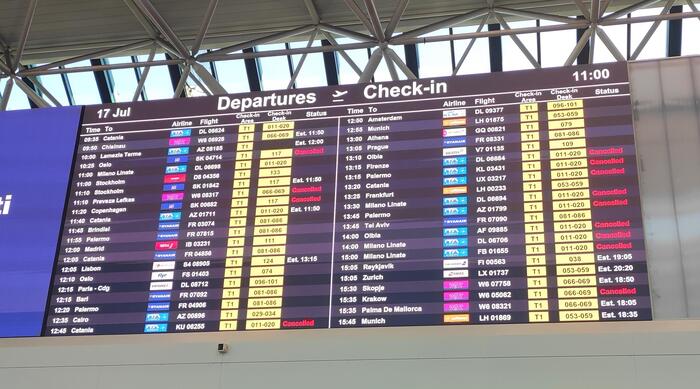Scioperi Italia: Governo in Azione per i Cittadini - Proteggere i Diritti e la Normalità
Editor’s Note: Scioperi Italia: Governo in azione per i cittadini. This article provides an in-depth look at the ongoing strikes in Italy and the government's response to mitigate their impact.
Why This Matters: Navigating the Impact of Italian Strikes
Italy is currently facing a wave of strikes across various sectors, impacting transportation, public services, and the daily lives of citizens. Understanding the reasons behind these actions, the government's response, and the potential consequences is crucial for both residents and those planning to visit Italy. This article will delve into the specifics of the current strike actions, analyzing their causes, the government's strategies for minimizing disruption, and the broader implications for the Italian economy and society. We'll explore the rights of both striking workers and the public, examining the delicate balance the government must maintain. Keywords: Scioperi Italia, scioperi trasporti, governo italiano, diritti dei lavoratori, servizi pubblici, economia italiana, proteste Italia.
Key Takeaways:
| Point | Summary |
|---|---|
| Causes of the Strikes | Varying reasons, including wage disputes, pension reforms, and working conditions. |
| Government's Response | Negotiations, emergency measures to maintain essential services, legal frameworks. |
| Impact on Citizens | Disruptions to transport, public services, potential economic consequences. |
| Long-Term Implications | Potential for legislative changes, economic shifts, and social unrest. |
Scioperi Italia: Understanding the Current Situation
The recent surge in strikes across Italy highlights growing concerns amongst workers regarding wages, working conditions, and the future of the Italian economy. These actions are not isolated incidents but rather symptoms of deeper societal and economic challenges. The current situation demands a careful analysis of the various factors contributing to the widespread industrial action and the government’s attempts to address them.
Key Aspects of the Strikes:
- Transportation Strikes: Disruptions to train, bus, and air travel are significantly impacting commuters and tourists.
- Public Service Strikes: Closures or reduced services in hospitals, schools, and other public institutions are causing widespread inconvenience.
- Wage Disputes: A central theme is the demand for higher wages to keep pace with inflation and the rising cost of living.
- Pension Reforms: Proposed changes to the pension system are a major point of contention.
Detailed Analysis:
The government's response has involved a combination of negotiations with unions, implementation of emergency measures to maintain essential services, and the reinforcement of existing legal frameworks governing strikes. The effectiveness of these measures is debated, with some arguing they haven't adequately addressed the underlying issues. Notable comparisons can be drawn to past strike actions in Italy, examining what strategies have been successful and what hasn't.
Intervento del Governo: Mitigazione degli Effetti
Gestione delle Emergenze:
The Italian government’s intervention focuses on mitigating the impact on essential services. This involves deploying emergency personnel, coordinating alternative transport options, and ensuring hospitals maintain basic functionality during strike periods. Understanding the government's strategies for crisis management offers crucial insights into its ability to respond to large-scale social unrest. The role of regional governments in supporting citizens during these disruptions is also vital.
Facets: The government’s response includes legal frameworks that balance the right to strike with the need to maintain essential services. Examples of emergency decrees and their effectiveness need to be analyzed. Risks of insufficient response are contrasted with the potential risks of overly harsh interventions. The impacts of the government's actions on both strikers and citizens need to be comprehensively assessed.
Domande Frequenti (FAQ)
Q1: What is the current situation regarding strikes in Italy?
A1: Italy is currently experiencing widespread strikes across various sectors, impacting transportation, public services, and the daily lives of citizens.
Q2: Why are these strikes happening?
A2: The strikes stem from various factors, including wage disputes, concerns over pension reforms, and dissatisfaction with working conditions.
Q3: How is the government responding?
A3: The government is engaging in negotiations with unions, implementing emergency measures to maintain essential services, and enforcing existing legal frameworks.
Q4: What are the main challenges faced by the government?
A4: The government faces the challenge of balancing the right to strike with the need to maintain essential public services and minimize disruption to citizens' lives.
Q5: How can I stay informed about the strikes?
A5: Stay updated by monitoring news outlets, official government websites, and transportation company announcements.
Practical Tips for Navigating the Strikes
Introduction: Staying informed and prepared can significantly reduce the impact of the strikes on your daily life or travel plans.
Tips:
- Check Transportation Schedules: Before traveling, verify train, bus, and flight schedules for potential delays or cancellations.
- Plan Alternative Routes: Consider alternative modes of transportation or adjust travel plans to avoid affected areas.
- Stay Updated: Monitor news reports and official announcements for the latest information on strike activity.
- Be Patient: Expect potential delays and disruptions and allow extra time for travel.
- Contact Service Providers: If you have appointments or services affected by the strikes, contact the relevant provider in advance.
- Check for Government Updates: The government’s website may provide helpful resources and updates.
Summary: By taking proactive steps and remaining informed, you can minimize the impact of these strikes.
Sommario
The ongoing strikes in Italy highlight deep-seated economic and social concerns. The government's response is a balancing act between respecting workers' rights and ensuring the continued functioning of essential services. Understanding the complexities of this situation is crucial for navigating the current challenges and informing future policy decisions.
Messaggio Finale
The situation in Italy underscores the importance of ongoing dialogue between workers, unions, and the government. What lasting changes will emerge from this period of unrest? Let's hope for a resolution that benefits all parties. Share this article to help others understand the situation and its impacts.
Call to Action (CTA)
Stay informed about the latest developments by subscribing to our newsletter! [Link to Newsletter Signup] Also, share this article on social media using #ScioperiItalia #ItalyStrikes.

